When a Tripawd shows signs of slowing down, many people immediately start shopping for a leg brace. But on today’s Tripawd Talk Radio podcast with Ben Blecha of Hero Braces, we explain why it’s important to follow the right steps before buying a leg brace for Tripawds (and potentially injuring your pet!). Tune in to learn everything you need to know about choosing braces for Tripawds and other furry companions..
Can’t listen to the Tripawd Talk podcast now? Read the full transcript below and learn what you need to know for braces for Tripawds and other dogs (and sometimes cats!).
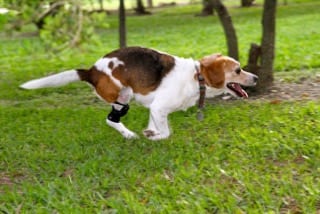
Thinking of getting a brace for your Tripawd? Find out why custom orthotics are best and why it’s important to consult with your vet first, on this episode of Tripawd Talk Radio.
Transcript: Orthotic Braces for Tripawds; Why a Custom Fit is Best
As an amputee himself, Ben Blecha understands the importance of comfort and function for prosthetics and orthotic devices. But when it comes to dogs, you can’t just ask them how they feel to determine a perfect it. That’s why he founded Hero Braces in 2005, to help provide limb stability for dogs who need it. Check out the work Hero is doing at GoHeroGo.com.
Whether used as an alternative surgery, or to help provide support when missing a limb, custom orthotic braces are the best solution. Let’s find out why. Thanks for joining us, Ben. Welcome to the show.
Ben Blecha: Hey, thank you. Thanks for having me.
Tripawds: Ben, thank you so much for being here. We’ve known each other for a few years now and really appreciate the fact that you took time today to be on our show. We’ve been wanting this to happen for a long time, so thank you.
Ben Blecha: Yeah, I always enjoy talking to you guys. It’s a lot of fun.
From One Amputee to Another, He Gets It
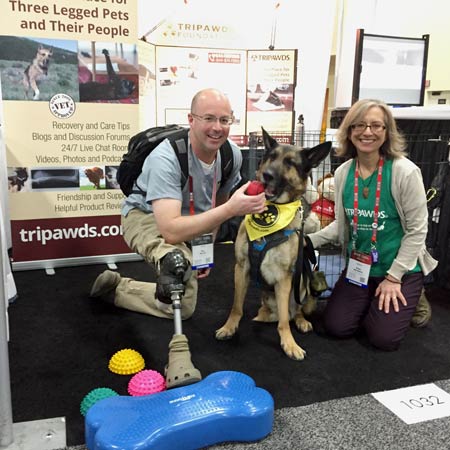
Tripawds: Oh, thanks. Well, for those unfamiliar with your story, let’s talk about you for a little bit. Tell us your own story and how everything in your life has impacted your career choice in founding Hero Braces.
Ben Blecha: Well, yeah, pretty much it has directed everything to it I guess. When I was in high school, I was 16 years old, I had osteosarcoma in my distal femur in my knee. And I’m sure a lot of the listeners know about osteosarcoma. They told me that I had about a 10% chance of making it.
And so, it was a scary time being 16 years old. I was really focused on sports and whatnot. And we ended up replacing my knee and taken the tumor out. I had some – a year of chemotherapy and I’m still here 28 years later, so that’s the good news from it.
Ben Blecha: Yeah. Yeah. And that knee replacement, I busted the stem out of my femur and then we replaced it again and then that got infected and then we pulled out all the knee replacement and so I had several months of IV antibiotics and we were just trying to figure out what we could do to save the leg. And basically, it came to the point that I was going to have to have my leg amputated and it was going to be a really high amputation.
So what the doctor said, “From your knee down is still good, so what we can do is we can actually amputate the knee and we can turn your foot around and we can bring it up and make it your knee and connect your tibia to your femur.”
I’m speaking with my hands right now so people can’t really see it, but basically my foot is on backwards and it’s at my knee now. And it’s a really odd amputation I guess. And I was actually in engineering school in college at this point because I spent several years trying to save my leg and whatnot and I kept going to my prosthetist and saying, “He, can you make it this way?” And, “No, you can’t do that.” So finally I just said, “I’m going to school for this.”
I went to prosthetics school. Yeah, that’s what got me there for that. And it was sort of the human side. I mean there’s no training for the canine or veterinary side of prosthetics and orthotics, right? And that’s what I went into is the human side.
Animals inspire his passion for making mobility better.
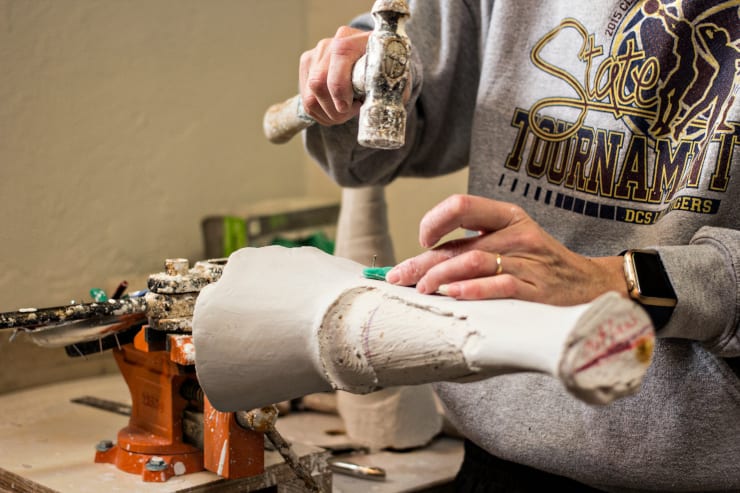
And I kind of bounced around the country. I worked at the Shriners Children’s Hospital and a couple of different places. And at one point, I was living in Denver and my uncle is a veterinarian and he introduced me to Dr. Taylor at Alameda East where they shot Emergency Vets (tv show).
When I was there, I started making prosthetics and braces and all sorts of things for Dr. Taylor and what he was doing there and Carey Adrian and we had a lot of fun there.
And then – I guess it was in 2008, I was asked to speak at the International Veterinary Physical Therapy Meeting, it has got more words in it, but – and at that point, people all over the world started asking me to start making prosthetics and bracing for them. I only make bracing now – I kind of made the decision at that point just to do bracing. But I started making bracing for people all over the world at that point and that became my full time gig. That’s where I am today. We continue to grow and make braces.
Why He Doesn’t Make Prosthetics
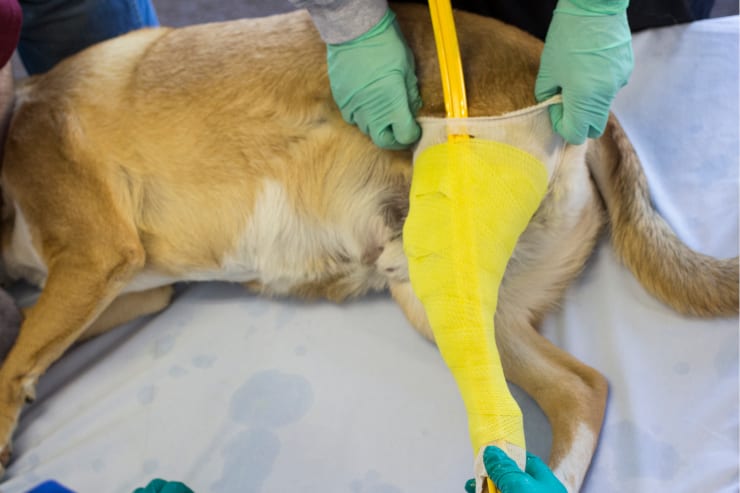
Ben Blecha: I quit making the prosthetics – I think you asked me to kind of talk about this, but I quit making the prosthetics because I really felt like I needed to get my hands on the dog to fit a prosthesis. Being an amputee, I know how like – how intimate of a fit it has to be for it to really be successful.
I just really didn’t feel like I could do that from a distance. And then the second problem is, it’s so hard to hold on to a dog’s leg with a prosthesis. In humans, we can use these jaw liners that kind of stick to the skin and you can kind of hold on. But with the fur, it kind of adds that element that makes it really tough.
We did some stuff called osseointegration where we basically, with Dr. Taylor, we basically put a little metal rod that comes out and they enter the bone and out and into the skin and then you can connect the prosthesis to it. The problem with that is, is that it gets infected and then it kind of breaks free.
There are some really smart people still working on that on the human side, so if we can ever get that buttoned down then I’ll start doing prosthetics again. But I really focus on the bracing because we can put a brace on an animal much easier than a prosthesis.
Hero’s Three Best Braces for Tripawds and Other Dogs
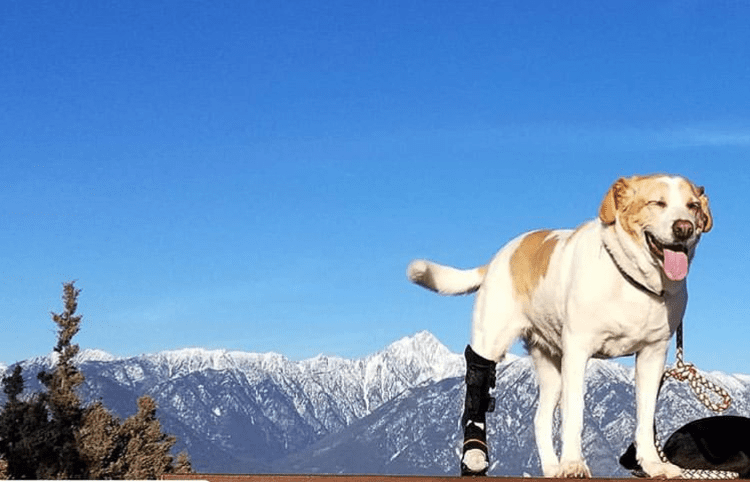
Tripawds: And when it comes to braces now, a lot of people when their Tripawd starts limping really badly or just showing signs of chronic pain, the first thing they want to do is rush out and go get a brace. And we will talk about that in a second, but for now, can you tell me what are the different kinds of braces that are available for pets and what are they commonly used for?
Ben Blecha: Well, I focused – I mean there are a few others but I focused on primarily three joints, the stifle, the knee or the hock or the ankle, and then the carpus or the wrist. Those are the three that I primarily focused on. Some people try to brace the hip and the elbow. It gets much more complicated for those. There’s also a brace for the shoulders that is already pretty good so I just never really try to do anything with that one. DogLeggs does a shoulder brace that’s pretty good in helping stabilize the shoulder.
The hips are really hard to hold on to to be able to brace. Everything likes to slide over the ramp and the contraption starts to get pretty complicated in trying to align hip joints and all these different things.
The elbow is really tough because much of the motion in the front leg comes at the elbow. And to stabilize an elbow, you have to stop the motion and your dog doesn’t really have any way to propel the leg forward if you stop that motion.
The other thing is, is to put a joint on the elbow on the inside, it will rub against the chest wall of the dog. And elbows are just really, really tough to do anything with. The most luck that we found is that the carpus and the stifle and the hock is where we look at.
Why many vets still don’t know about braces for dogs.
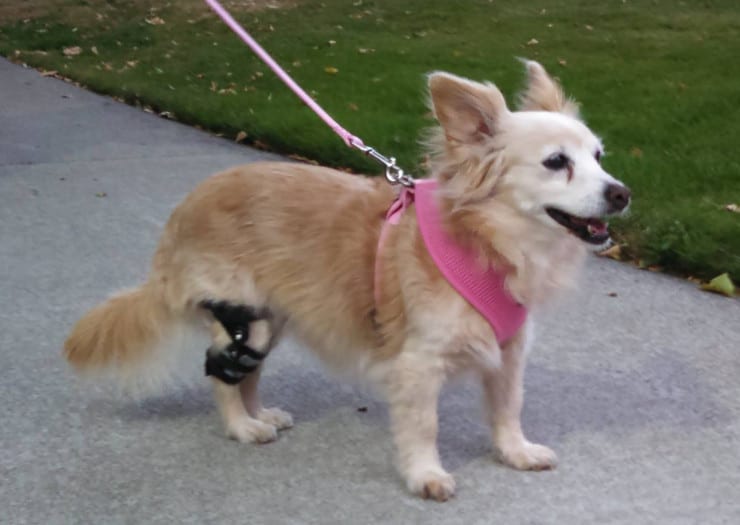
Tripawds: I want to back up for a second real quick because earlier you mentioned how there is no specific training for veterinary orthotics and prosthetics makers. Right now, is that because the field is still relatively new and you guys are just kind of learning things as you go?
Ben Blecha: Yeah. Yeah. I mean there’s a handful of us that are around. There are about four or five custom companies that have been around since about 2004, 2005. There are a couple of off-the-shelf braces that came out around 2000.
I know that sounds like 15 or 20 years. It seems like a long time. But when you think about an industry or a medical profession, it’s pretty short. And it’s just slowly starting to – veterinarians are slowly starting to adapt more prosthetics and orthotics into their practice but it’s not widely tied in veterinary schools yet either. It’s a practice in patients I guess.
When does a Tripawd need a brace?
Tripawds: How can a brace help a Tripawd and do they work with cats?
Ben Blecha: Right. Well, I’m going to start with cats real quick. Cats, they are more finicky. So basically what I always say is if you’re going to try a custom brace which is much more expensive, what we usually do is we will just send you a little slab of – a little piece of neoprene that you actually try to put on the cat’s leg to see if they will wear it first. Because if they’re not going to wear it then you shouldn’t really try to take the next step. But cats, yeah, they can wear brace very similar to a dog. So – what was the first – oh, the first question was the Tripawds.
Braces can help Tripawds but the thing is, is we have to remember that since we are down one leg, we’ve lost a lot of propulsion. OK? So how do we move forward, how do we jump, all these different things. And when you start doing bracing, a lot of times what you have to do is limit some sort of motion to support the leg. I generally shy away from bracing early on with a lot of Tripawds. OK?
Now, it’s a tough spot like you have to kind of figure out where’s this pain level and where do I start taking away some motion to try to support to limit some of that pain? And every dog is a little bit different and I think it’s really tough too because we can’t sit and carry on a conversation at the end of the day and say, “Hey, how’s your ankle feeling?”
First, address pain
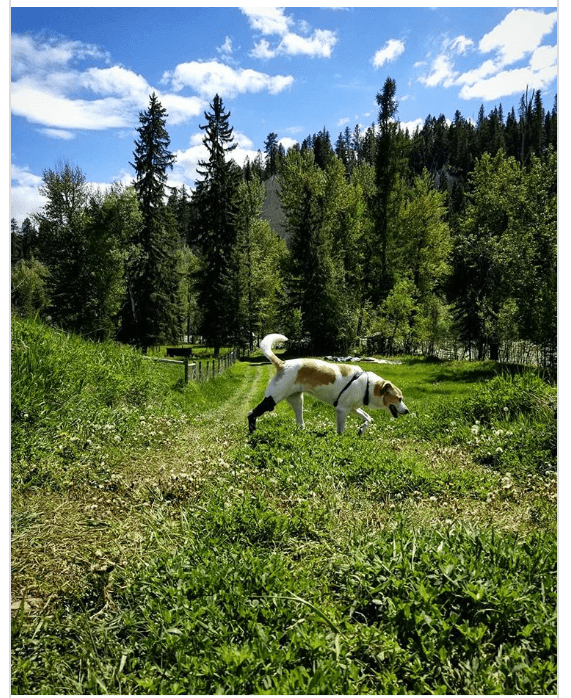
And you kind of have to start gauging. One of the best ways to gauge is just their activity level, right? If you really see that their activity level started to go down then we need – it’s probably a pain issue that we need to start addressing something. OK?
And if you want to start bracing early on especially for the hock and carpus, what I would suggest is doing something, a more soft brace, maybe like a DogLeggs or a Thera-Paw brace. Those will not limit all of the motion but they provide some support it’s kind of have that happy medium.
Then consider a custom brace.
As the pain and the deformity gets to be more and more then you need to start doing something more custom and that’s where I fit in in what I do is that custom braces. They are more rigid and they provide more support.
The stifle is a little bit different. Generally what we are trying to support that for is if there’s a torn ACL or cruciate, that can happen, and basically with the stifle brace, we are still allowing the “normal knee motion.” What we are trying to do is we are trying to limit this bad motion called the cranial drawer. You can do a stifle brace pretty much anytime and it’s going to help provide that support so they can continue to put that like especially if they’ve lost a hind limb. They don’t have another limb back there to support. You need to get a stifle brace on them right away if they have a cruciate tear.
That’s kind of the general – I mean depending on the deformity, it can get more specific than that. But that’s generally what I’m looking at when I’m suggesting things for a Tripawd. Is that kind of what you hear?
How does the brace process work?
Tripawds: You work with pet parents directly but you also work with rehabilitation therapist, is that correct?
Ben Blecha: Yeah. Primarily what we do is if the vet – the pet parent contacts us. We try to direct them to a veterinarian. That’s the best way that we can help people, because all these things are custom-made so we need a cast of the leg. If you and I were to tear our ACL, there are 14 different sizes. Well, there are over 200 breed of dogs. We would have to have hundreds of different sizes. That’s why we do everything custom for those braces.
Why you need to work with your vet for a brace.
Tripawds: And what are the dangers or drawbacks of using an off-the-shelf brace that wasn’t prescribed? You can go out there and you can get them anywhere. We see a lot of people reaching for that and we would tell them, “Wait a minute. Wait a minute. Talk to a vet. Talk to an expert first.” What are the problems involved when somebody self-prescribes a brace?
Ben Blecha: Right. Well, I mean the first issue is just the fit. I mean think about just different breeds. Think about how much a German Shepherd crouches compared to other breeds. There are different angles of all these joints that we are trying to support. If you try to put an off-the-shelf brace, I call it a one-size fits none, but put it – it will rub sores and it’s just not comfortable.
And I think that’s kind of where bracing has got a black eye in a way because they’re like, “Oh, see that dog is not walking well with it.” Oh yeah, because you didn’t think about what you are doing. You just try to hold on tight and hope it did something.
Cheap dog braces versus expensive custom dog braces.
Fabric braces are a little bit more forgiving so you can have some off-the-shelf braces and the downside is they don’t provide as much support so it’s maybe better for smaller dogs or maybe a milder deformity. But once you really have – you really need support, that custom is important for the fit.
The biomechanics is another part like how are we really supporting it? Is it going to provide that correction that you need?
I really believe with the stifle brace. The cranial drawer motion, basically your tibia bone, the lower bone in your knee, it kind of shifts forward. And if you try to hold on to that with fabric, think about how much your shirt stretches if you just grab on to your sleeve. How are you going to try to limit that motion with fabric? It’s just – it’s not really possible to do, especially for the stifle in a cruciate brace. You need something with a more rigid plastic that’s going to support that.
Tripawds: What are your braces made out of?
Ben Blecha: We use – it’s a – it’s not polycar – it’s a copolymer. It’s a mixed of polypropylene and polyethylene. We found it to be a really light weight and we can adjust it as needed, very durable.
Tripawds: Let’s say that someone goes to their vet and the vet says, “Yeah, this dog can use a brace or cat.” And then they turn to you. What happens from the moment they contact you? How does everything unfold?
Why your vet must be involved.
Ben Blecha: Yeah. Yeah. People order on our site and it gives some of the information about their dog like the weight and breed and stuff like that. And from that, we will send this little casting kit to your veterinarian and there is some casting and fitting videos on our website to kind of help with this process. But they take a cast of the leg in a specific position and then that cast is sent to us. We make a model of the leg and fabricate that. That takes a couple of weeks. We send it back for fitting.
And then if you have any fitting issues or concerns, what we do is we would do a video call like FaceTime or Skype or something like that to help you through that processes if you or your veterinarian hasn’t done this before. We really want to help with the customer service. I just – I’m an amputee. I know what the support needs to be and I want everybody to feel important that way.
Tripawds: Oh, that’s awesome. People look at the price. I mean you are right up front. You show exactly what your braces cost on your website. And a lot of people, they see that price and they are like, “Oh my God!” for any custom brace, not just yours.
Ben Blecha: Right.
Tripawds: But there are a lot that goes behind that investment. I mean there’s all the time you spend with the casting process and the video consults and just making sure that it’s a good fit. We really encourage people to look past that dollar amount because this is kind of – this is a long term investment for the health of our animal and it’s totally worth it if you’ve got a dog who can move without pain once they’ve got the brace.
Why Hero Braces Stands Out from the Rest
Ben Blecha: Yeah, and I mean – I know it’s a tough thought to spend that amount of money and what we really try to do is we make it simple. This is one cost. We don’t charge you for adjustments if there need be. We don’t charge you for video consults. We don’t – like all the customer service, all those things, I mean for the life of your dog are included with it. The plastic and joints are guaranteed for the life of the dog. The fabric stuff, if that wears out, we have minimal fees for that but that’s like if your shirt wears out.
We really try to make this all-inclusive and one price. We don’t like – I don’t like being nickel and dime and I don’t want to do it to someone else. It’s important to me that way.
Tripawds: That’s awesome. Do you only work with people in the US or do you work with people in other countries?
Ben Blecha: Yeah. No, we’ve worked all over the world. We had a call from Lithuania one time. I never thought that I would be sending to the – when I grow up, that was a part of that world that the US couldn’t really access so it’s pretty cool.
Tripawds: I just wanted to end this discussion by asking you, I know what makes Hero Braces stand out from everybody else but if you could give us the 30-second elevator pitch and tell the world why your products are awesome, that would be great.
Ben Blecha: Well, I hope I gave it already. We just want you to succeed. And I want to be genuine about that. Ask us whatever and we will help you however we can.
Tripawds: You are so awesome, Ben. I really, really appreciate you being here today. Thank you so much.
We encourage listeners to talk with their vet first when considering a brace for the Tripawds. For more information, visit GoHeroGo.com. And for many more, articles, video interviews and podcast about orthotics and prosthetic options for dogs and cats, search the blogs and forums at Tripawds.com.
[End of transcript]
How do I get a casting kit for my vet & I?
I have a dog with a rear left leg amputation , German Wirehaired pointer, 55lbs
JoAnne, please reach out to Hero Braces directly so they can help.
Thanks for this podcast,,,,we’re at a point where our Tripawd is starting to slow his activity levels.. he’s 6yrs. and we definitely want him to be happy and pain free for as long as possible. Definitely going to pursue more advice and information. Thanks.
That’s awesome Don, glad it helped. Please consider checking out the Tripawds Foundation Rehabilitation Reimbursement program to get your pup assessed by a PT, free!